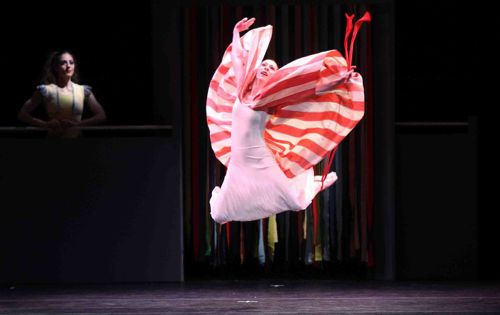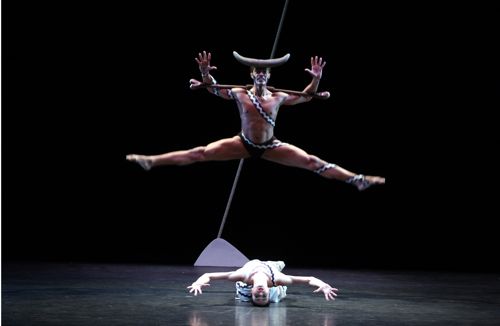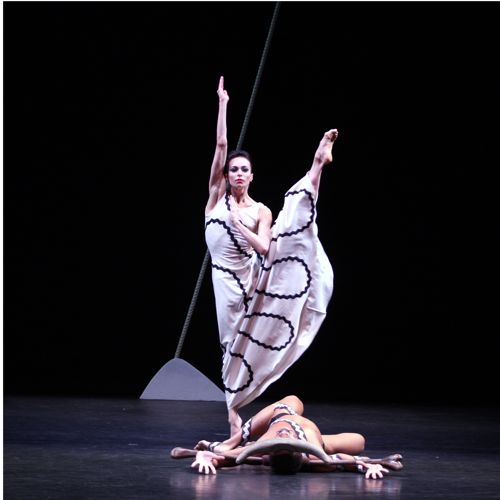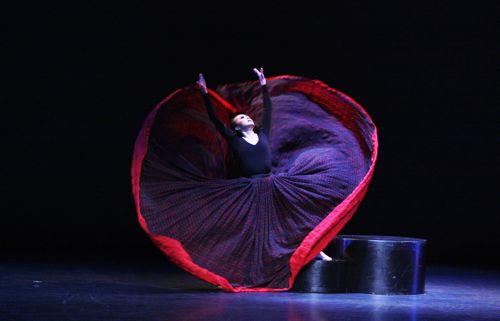Martha Graham Dance Company / Joyce Theater, NYC, and City Center, NYC / March 13 – 18, 2012
Martha Graham, performing Lamentation (courtesy YouTube)
Everything that lives must die, as a colleague explained gently to her very young daughter, when the child was wrestling for the first time with the idea of death. The idea is also applicable to even the most glorious dance institutions, such as the Martha Graham Dance Company, on view for a week at the Joyce Theater.
I saw the first of the two ordinary repertory programs offered. It opened with a murky, jittery video collage—meant, as company director Janet Eilber likes to say, to “contextualize” the live dancing that would follow. Eventually.
Mary Wigman, performing Witch Dance (courtesy YouTube)
The live stuff began with Mary Wigman’s 1926 Witch Dance, in homage to Graham’s legendary predecessor in the realm of Expressionist dance. Actually Graham was pretty much sui generis, but let that pass. The raw solo for a masked woman in picturesque rags is composed of terrifying crazed moves occasionally gentled by a phrase of fleeting, meditative sensuousness such as the hand stroking the cheek. PeiJu Chien-Pott made a good, if dutiful, job of it.
The program moved on to Graham’s own work with the 1939 Every Soul Is a Circus, which borrows its name from a Vachel Lindsay poem. The dance is a rare instance of this choreographer’s aiming for comedy—or, at least, satire. Graham’s subsequent work would prove that she was instinctively tragic, dramatic, and melodramatic, an artist who looked deeply into the human condition and was not amused.
 Blakeley White-McGuire as the Empress of the Arena in Every Soul Is a Circus
Blakeley White-McGuire as the Empress of the Arena in Every Soul Is a Circus
Photo: Costas
In Circus the Empress of the Arena is Graham herself. When she flings herself onto her couch, hysterical because she can’t transform her vision into reality, she’s behaving as history records Graham doing in real life. The Empress is relentlessly observed by the Ideal Spectator, a motionless (and noncommittal) woman, and courted by a sturdy, take-charge Ring Master (Tadej Brdnik, originally Erick Hawkins) and a buoyant Acrobat (Lloyd Knight, originally Merce Cunningham in his first role with the troupe). The ensemble is represented by five jeunes filles en fleur in pretty pastel dresses—one already successfully working her way to stardom. Their stage is a mid-century (20th) toy theater, with nothing more substantial than sparse furniture that resembles playthings, while red ribbons and a swath of red cloth indicate proscenium and curtain. This is a world created from nothing, Graham proposes, and the Empress is so foolish as to assume she can make high art out of it. Of course, in real life, she did.
Unfortunately Circus falls flat today—some quarter-century since it was last performed—largely, I suspect, because its current audience is not steeped in the heady Graham legend, and partly because Blakeley White-McGuire is unconvincing as the Empress.
Night Journey, with Graham as Jocasta (courtesy YouTube)
Night Journey, from 1947, the most important dance on the program, suffered from the same inadequacy of casting. Looking at Katherine Crockett, as statuesque, beautiful, and impassive as a fashion mannequin (heaven-sent as the woman in white in Diversion of Angels), it’s almost impossible to imagine her as Jocasta, doomed to mate unwittingly with her son, who—well, you know the terrible tale. This problem of casting against the grain arises repeatedly now because the company no longer commands enough dancers of the highest caliber to take on Graham’s leading roles appropriately. (This is ironic, since Graham originated almost all of them herself.)
At any rate Crockett worked hard to inhabit her role and, by the midpoint of the dance, she had become convincing—in her erotic desire, in her intimation of the curse and the resultant sin that would destroy her, and finally in the horror of her situation as it was finally revealed, a situation to which suicide was the only solution.
I can’t help wishing that the celebrated seven-woman Chorus—a leading character in itself—had been even keener in its unison and thrust. It still registered as a highlight of the choreography, as did the motherly gestures, including a pietà pose, of Jocasta toward Oedipus in the course of their erotic duet.
I’m making no comment on Lamentation Variations because the very idea behind it—inviting other choreographers, mediocre ones, more often than not, to do a gloss on Graham’s singular achievement—seems to me a desecration of the original, which happens to be perfect.
 Diana Vishneva, with Abdiel Jacobsen, in Errand Into the Maze
Diana Vishneva, with Abdiel Jacobsen, in Errand Into the Maze
Photo: Costas
The day after the opening the company moved uptown to the more capacious City Center for its gala. Featuring the Russian ballerina Diana Vishneva, the evening was likely to attract a larger audience. Partnered by Abdiel Jacobsen, Vishneva danced one of Graham’s landmark works, the 1947 Errand Into the Maze, a duet about conquering fear, based on the Greek myth of Ariadne and the Minotaur. Vishneva had already had a big hit with it in her homeland.
A number of prominent ballet dancers have, in their time, attempted to dance Graham’s works. I recall with dismay Margot Fonteyn (sweet and dutiful) and Rudolf Nureyev (irresponsible) and the Blackglama “What Becomes a Legend Most?” ad that promoted their misalliance with Graham. Classical ballet technique and the vocabulary Graham invented are two distinctly disparate languages, each taking years to master and leaving their impression on a dancer’s anatomy and posture and how she instinctively—incontrovertibly—moves. So I was astonished to see that, to a remarkable degree, Vishneva brought the task off.
 Vishneva, with Jacobsen, in Errand Into the Maze
Vishneva, with Jacobsen, in Errand Into the Maze
Photo: Costas
A vulnerable-looking woman (all of Graham’s chief protagonists are female) contends, three times, with a brute creature (half man, half beast) who fills her with an unspecified but all-pervasive terror. Twice she drives him away; the third time she drives him away for good and retreats to her Noguchi-constructed home base and removes the rope that once barricaded it, opening the door, so to speak, to an unhampered life.
I think Vishneva was convincing because she operated here just the way she does, to great acclaim, with her classical-dance roles, leaving nothing to impulse or chance, but investigating exhaustively what is required and figuring out how to produce it. Her tenacity is a marvel. Granted she hasn’t quite mastered the whiplash energy typical of a Graham dancer and she’s not best buddies with staccato timing, so some of the choreography is smoothed out. But she understands her material and, I think, respects it. This wasn’t merely a star turn.
Photo: Costas
Fang-Yi Sheu, once an unforgettable star with the Graham company, returned for the occasion as a guest artist in the 1936 Chronicle. A powerful dance for 12 women used chorally, with the figure Sheu played as instigator and inspiration, it’s a striking metaphor for the power of women in the face of war and desperate poverty. Sheu’s technique has understandably diminished but she’s as theatrically compelling as ever. In this role she exudes a saintly charisma. Who wouldn’t take action at her behest? I felt ready to execute the hundred jumps the chorus is said to perform or, more realistically, the community-service equivalent of same.
A small but delightful curtain raiser to the main events was the duet from Appalachian Spring, performed by the two best dancers in the company, Miki Orihara (as The Bride) and Tadej Brdnik (as The Husbandman). The pair fit their characters well, danced with touching attention to detail and the authenticity achieved through an in-depth familiarity with the piece. The performance closed with Diversion of Angels—the sole major Graham work that presents happiness undiluted. Lloyd Knight stood out here, as he does in everything he dances.
During the two evenings that I watched the present-day version of Graham, I saw to a heartbreaking extent how her company has diminished—not just in first-rate dancer power, but in astute direction, public popularity, and (apparently) funding. Yet seeing a few of Graham’s greatest works, even under far from ideal circumstances, I felt more convinced than ever that these treasures should survive and be properly performed. Still, for the life of me, I can’t see how that is going to happen.
© 2012 Tobi Tobias




